Visitperth.ca
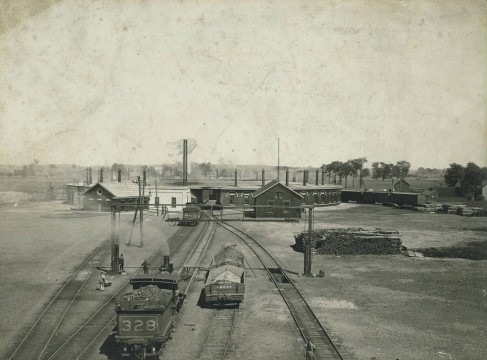
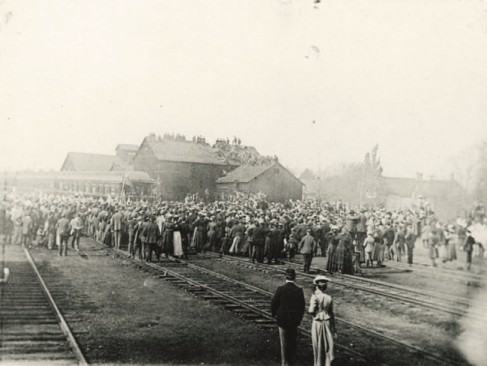
The Ties That Bound a County
Railway Heritage Tour of Perth County
Railway rivalry, expansions and an even an explosion created drama in Stratford and Perth County long before any actor set foot on a stage. Experience the railway heritage of Stratford, St. Marys and Listowel while hiking along former railway lines, learning about the interesting people who helped build the railway's strong hold and viewing some of the last, and best preserved railway buildings in Ontario.
Well into the 1850s, the earliest years of settlement in Perth County, the road systems were very poor. It is not surprising that railway rivalries beginning in 1849, saw the more prominently settled south end being courted by not one but two railways. Financial difficulties and bankruptcies led to railway mergers, resulting in the Grand Trunk Railway. The GTR and the Buffalo and Lake Huron Railway Company were the two railways vying to be first. Both of which arrived in Stratford in 1856. In turn, new stations were opened in the neighbouring villages of Shakespeare and Tavistock. Further railway expansions included the Grand Trunk extending the railway to St. Marys with lines to London and Sarnia by 1860 and the B&LHR extending their railway to Mitchell and Goderich by 1858. New stations also developed at Sebringville, Mitchell and Dublin. By 1877
a line had reached the north end of the county at Listowel, resulting in the merger of the Stratford and Lake Huron Railway Company and the Port Dover and Lake Huron Railway. They were taken over by the GTR in 1881.
The GTR continued to gain strength in 1882 when difficult times for the Great Western Railway, the GTR's arch-rival, provided the opportunity to purchase. The GTR had a monopoly in railway service until 1902, when the Canadian Pacific Railway, through a number of subsidiary companies, tried to break the GTR's hold. The first line completed in 1907, made an east to west cut across the centre of the county through Millbank, Milverton and Monkton, in addition to a line from Linwood to Listowel. The other CPR affiliate was the St. Marys and Western Ontario Railway. Original plans to connect crucial links through Stratford had the proposed rail line run through the cherished parkland along the Avon River. The CPR gave up its struggle to connect the Perth County parts of its network when, after much opposition, its plan was defeated in a public referendum in Stratford. Without a connection through Stratford, the Listowel branch was closed in 1939. The GTR on the other hand, became one of the main components of the Canadian National Railway (CNR), the new government-owned Trans-Canada railway company in 1923.
The decline of the railway resulted in the growing popularity of the automobile as well as improved highway networks through the province. In 1970 CNR and CPR cancelled all passenger service with the exception of selected main lines. St. Marys and Stratford are fortunate to still have passenger service today through VIA Rail Canada. A similar trend in freight traffic saw the closure and removal of most railway lines in the county by the early 1990s. The first two to be built – the Grand Trunk mainline through Stratford and St. Marys and the Stratford-Goderich lines are still in existence today.
The arrival of these first railways brought not only a revolutionary change in communication with the outside world, but along with the railway-related industry of the shops, the railways also allowed for easy shipments of goods to markets across North America and overseas. Perth County was one of the leading areas in Canada for the dairy industry for well over a century, as well as Stratford, with its ten or more furniture factories, producing approximately one-sixth of all the furniture in the country.
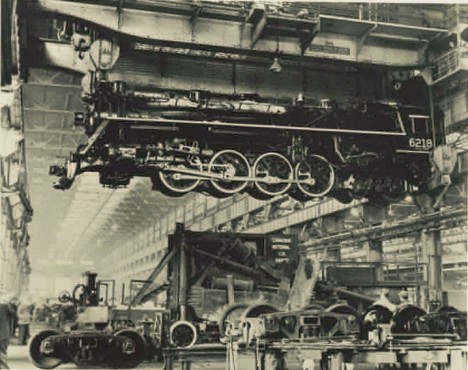
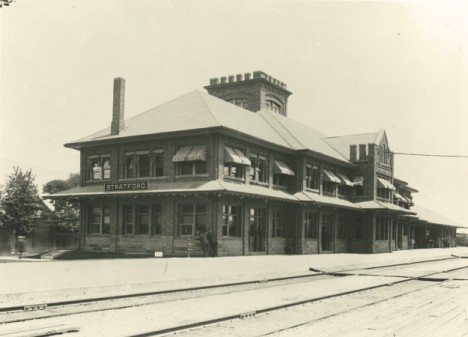
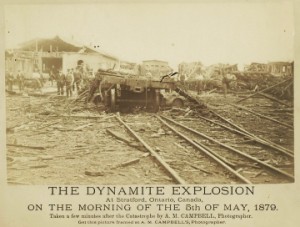
In the late 1860s the city of Toronto ordered the Grand Trunk to get its workshops off the harbor front, and for a while every small city and town in southern Ontario was trying to get the shops to relocate there. The man who had to make the decision was the railway's manager of locomotive maintenance, Herbert Roberts.
Stratford's then-mayor, T.M. Daly, invited Roberts for dinner. Roberts met Daly's attractive daughter. It was love at first sight and within weeks there was no chance that the shops would be anywhere but in Stratford.
It was that decision by the Grand Trunk Railway in 1870 which turned Stratford almost overnight from a country village into the trade-training centre of the province at a time when government run technical colleges were still unknown. The 1,000 employees the railway brought to Stratford were craftsmen skilled in almost every technical trade that then existed. Apprentices trained in the shops spilled over into other
industries and formed the nucleus of craftsmen in a furniture industry that competed on national and international markets. Stratford had the best designed public, commercial and residential buildings in Southern Ontario, the designers of which were all by-products of the Grand Trunk shops.
Start at the corner of Downie & St. Patrick Streets with the heritage sign A Community and a Workplace, located in front of the YMCA building. Behind the YMCA, you will see what remains of the railway shops.
1. A Community and a Workplace, heritage sign
Cross Downie Street and turn right. Travel to Shakespeare Street to the heritage sign - Stratford's Railway History.
2. Stratford Railway Station - 101 Shakespeare Street.
The Stratford Railway Station was built in 1913 by the Grand Trunk Railway. The GTR chose to build this two-storey station in the "prairie style" - an architectural form of the time popularized by American architect Frank Lloyd Wright. The brick and stone building has characteristic long horizontal lines, hip roof with wide overhanging eaves and is without ornamentation. The original Station garden was considered to be the finest landscaping on any GTR property. Three royal trains made stops in Stratford. The Prince of Wales (later King Edward VII) in September 1860, King George VI and Queen Elizabeth in 1939 and Queen Elizabeth II with Prince Phillip in 1959.
A note of interest: In 1879 a shipment of vigor powder (powder taken from nitroglycerin) exploded resulting in the death of two workers and the devastation of the railway yards. Improperly labelled, to avoid certain regulations, the dynamite en route from Montreal to Windsor, leaked over the tracks and was detonated when the train's wheels ran over it. The explosion was so intense, many houses in the area sustained damages and a shipment of straw hats in an adjoining car was found scattered half a mile away.
Travel north on Waterloo Street to Douro Street. Turn right.
3. 27-29 Douro Street
Originally in charge of the GTR's drafting room in Montreal, John Davis Barnett was the master mechanic at the Stratford repair shops from 1880 to 1884. In a term lasting a little more than ten years, Barnett returned to Stratford to supervise the GTR's expansion operation in 1888. In addition to the railway, Barnett had a passion for books. In 1896 as president and a driving force behind the Grand Trunk's employee library, Barnett had 785 baths installed when workers complained of being too dirty at the end of their workday to use the library. His personal library consisting of 40,000 volumes, 1,500 of which
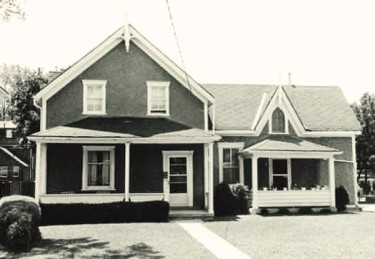
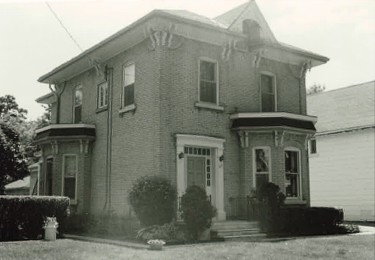
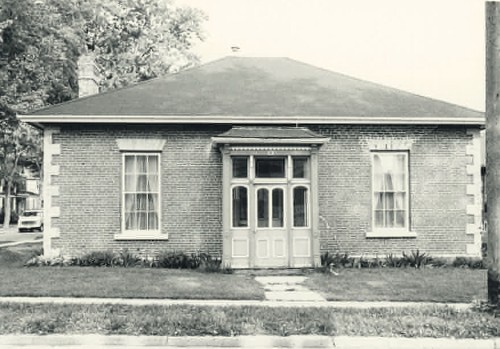
were related to Shakespeare, was said to have been the largest collection of Shakespeariana in North America. The collection was so extensive that it caused his home on Douro Street to sink two inches! In 1918, Barnett donated his beloved books to the University of Western Ontario, which had a mere 5,000 volumes in its library. To this day, books from J.D. Barnett's collection sit on the University library's shelves.
Continue to travel east on Douro Street.
4. 67 Douro Street - Designated under the Ontario Heritage Act.
Few residences in Stratford are more tied to the city's railway history than the two-storey, buff-coloured brick Italianate-style house at 67 Douro Street, which was built in 1880 for David Agnew, a locomotive engineer with the Grand Trunk Railway for 30 years. Frank E. Baker, a conductor with the Canadian National Railway, bought the house in 1922 and it remained in the Baker family until 1938. From 1946 to 1986 the house was owned by Fred J. Buckingham, a British-born machinist who was with the CNR until the locomotive shops closed. By the late 1950s, the Buckinghams duplexed the house, which is now a bed and breakfast establishment.
Continue to travel east on Douro Street to Nile Street. Turn left.
5. 87 Nile Street
In 1857, soon after the Grand Trunk Railway signalled prosperous times for Stratford, hotelier John Forbes and his wife Elizabeth had fellow Scottish immigrant William Easson build a red-brick cottage at 87 Nile Street (at what is now the corner of Nile and Brunswick streets). The Forbes initially lived in but later rented out the house, a Victorian carryover from Georgian Britain, with its centre-hall plan and no basement. John Forbes died in 1865, and in 1872 his widow gave the cottage to their daughter Jennie as a wedding present, as she became the bride of Dr. James A. Robertson. When the Robertsons built a larger house on an adjoining lot (157 Brunswick Street) in the late 1880s, they rented out their wedding present but, for sentimental reasons it remained in the family until the 1950s. Jim Anderson, the first archivist for Stratford and Perth County, bought the cottage in 1969 and spent much of the next decade restoring it. The house now operates as a bed and breakfast called the Jennie Forbes Cottage.
Travel north on Nile Street to Ontario Street. Turn left heading to downtown.
6. 46 Ontario Street. (Above Sputnik Coffee House)
This small apartment was once part of the Albion Hotel. Built in 1855, The Albion Hotel stood next door at 56 Ontario Street.
The prolific American inventor Thomas Edison (1847-1931) is hardly remembered as a telegraph operator, but it was in that capacity that he worked in the Grand Trunk Railway station in Stratford as well as the Junction Station in St. Marys. His father had been born in Nova Scotia, but the Edison family was living in Port Huron, Michigan, when young Thomas saved three-year-old Jimmie MacKenzie from being struck by a runaway train. Jimmie's father, a railway station agent in Mount Clemens, Michigan was so grateful that he trained Thomas as a telegraph operator. Edison was 16 when he got his first job as a telegraph operator, but he was fired soon after for experimenting with chemicals and causing an explosion. His second chance came in Stratford, where he is said to have stayed in the Albion Hotel, and was fired again, this time for failing to warn the engineers of two trains that nearly collided. When summoned to the office of W.J. Spicer, the General Manager of the Grand Trunk Railway in Toronto where Edison fully expected to be jailed for dereliction of duty, or fired on the spot. He took advantage of a momentary distraction of Mr. Spicer to slip out a side door, catch a train to Point Edward (near Sarnia), cross the St. Clair River by ferry and return to the United States.
Continue to travel west on Ontario Street. Turn right onto St. Andrew Street then left on Birmingham Street.
7. 91 Birmingham Street Designated under the Ontario Heritage Act.
English immigrant, William Trethewey, yardmaster at the Grand Trunk Railway shops, built this Ontario cottage. The house, with its central gable and hipped roof, remained in the Trethewey family until 1913, when it was sold to John Chesney, a depot master and detective with the GTR and later a policeman with the Canadian National Railway. John Chesney's son Pearson, who grew up in the house, also worked for the GTR and CNR as a machinist.
Travel back toward St. Andrew Street turning right onto St. Patrick Street. Continue to travel east on St. Patrick to the corner of Downie and St. Patrick Streets.
This concludes the Stratford portion of The Ties That Bound a County – A Railway Heritage Tour of Perth County.
To continue with the St. Marys portion of the tour, travel south on Erie Street where it will become Highway 7 /19. At Perth County Line 20 turn right. Travel to Perth Road 130 and turn left. The drive will take approximately 20 minutes.
As you pass the Welcome to St. Marys sign Glass Street will be on your left.
St. Marys
1. Junction Station - 480 Glass Street, Note the Historic St. Marys heritage sign, St. Marys Junction Station .
Built in 1858, the station was one of about fifteen built on the Grand
Trunk mainline between Montreal, Quebec and Sarnia, Ontario. Most were constructed of local limestone, using a similar design plan adapted from a station in Kenilworth, England. The station, designed by British railway architect Francis Thompson, is a model of simplicity with its rectangular shape, low pitched roof, wide eaves, French doors, circular vent at the gable ends and boxy chimneys at the corners. In June 1939, the Royal Train carrying King George VI and Queen Elizabeth on their historic trip across Canada, stopped briefly at the Junction to take on water. For more than eight decades, this was a busy location with numerous freight and passenger trains plying the rails daily. Unused since the 1940s, the St. Marys Junction Station is arguably the least altered of the few remaining Kenilworth-style stations. Now stabilized and protected by a fence, this architectural treasure stands proudly, offering a direct connection to the town's railway heritage.
Return to James Street North and turn left. Just prior to entering the residential area, on your right-hand side is the footpath entrance to the Grand Trunk Trail. You may park your vehicle along side the road and walk the trail to the Sarnia Bridge, or you may also access the trail from the north end of the park at Milt Dunnell Field.
2. Sarnia Bridge and the Grand Trunk Trail
The original Grand Trunk Railway line to Sarnia was abandoned by the Canadian National Railway in 1989. By 1993, the Town of St. Marys had purchased the right of way through town and in 1996 a volunteer committee was formed to raise money to convert the line, including the high-level Sarnia Bridge, into a community walkway. The Grand Trunk Trail was officially opened in 1998 and largely, because of the stunning vistas from the trestle railway bridge, has remained one of the town's most popular recreational areas.
Return to James Street North and continue south to Widder Street East. Turn right
3. 249 Widder Street
Built for Thomas Fogg, a manger of the Grand Trunk Railway, this house is actually a one layer thick brick veneer over a frame construction. The building's deception continues in the pedimented window headers, which are metal factory made units that snap on and off. The walnut door, original to the house, was built for Fogg at the carpentry shops of Sarnia's Grand Trunk Railway.
Cross James S treetNorth and continue along Widder Street East under the trestle bridge.
4. Railway Cottage, 404 Widder Street East.
Not all the buildings we value or associate with the railway are necessarily grand. Rather many are, or were, ordinary. Typical of a period railway cottage, this building adds to the personality of railway heritage, representing the hundreds of immigrants who built the railways.
Return to James Street North and turn left. James Street North will become Station Street. Continue along Station Street to Wellington Street. Turn left, then right onto Parkview Drive until you reach Milt Dunnell Field. From here you may park your vehicle and tour the Riverview Walkway by foot.
In 1857, contracts for two elevated bridges on massive limestone piers were called. Track lines were needed to cross over Trout Creek on the London line and the Thames River on the Sarnia line. The project was awarded to George Weir, a self taught civil engineer who made his reputation working on the Rideau Canal. The bridges became known as the London Bridge and the Sarnia Bridge.
5. Riverview Walkway. Note the Historic St. Marys heritage sign
along the Walkway, mid way between Park and Queen Streets,
Riverview Walkway - St. Marys & Western Ontario Railway.
Coming to St. Marys in 1908, this former right of way of the St. Marys and Western Ontario Railway, later part of the Canadian Pacific Railway, completed the well established Grand Trunk Railway. After 80 years of activity, CPR abandoned this section of track and thus, the Riverview Walkway was developed in 1992.
London Bridge, Grand Trunk Railway, St. Marys
This paved 2.4 km path travels from the centre of town south along the Thames River to Canada's largest spring fed swimming pool, The Quarry.
From Milt Dunnell Field travel south on Water Street to Queen Street East. Turn left and drive through the downtown to James Street North. Turn left.
6. St. Marys Train Station and the London Bridge: 5 James Street North.
Constructed in the summer of 1907 for the Grand Trunk Railway, this station was the third depot on the line at St. Marys, following the Junction Station erected in 1858 and the station at "The Switch" erected in 1879. E. Chandler of Stratford was the general contractor and possible designer of the station.
Purchased and refurbished by the town in 1988, it is now home to the offices of Tourism St. Marys as well as the VIA Rail passenger depot. It was designated as a heritage structure in 1987.
A note of interest: Stratford and area's location in the heart of the snow belt buried more than a few locomotives and plows. After serious storms resulting in major snowfall accumulations,
farmers and railway crew alike would work together, sometimes for days, digging them out with shovels.
This concludes the St. Marys portion of The Ties That Bound a County – A Railway Heritage Tour of Perth County.
Continue east on Queen Street, to Highway 7/19. Turn left onto Highway 7/19 and travel back to Stratford.
To continue with the Listowel portion of the tour, travel north on Highway 119 to Highway 86. Turn left. Highway 86 will become Main Street. Turn right onto Wallace Avenue North (Highway 23) to Binning Street West. Turn left and follow to the end of the street. Travel time from Stratford will be approximately 40 minutes.
Listowel
1. Former CNR / Grand Trunk Rail Station
Built in 1877, the former CNR/Grand Trunk rail station served Listowel and area well during its heyday however, the arrival of the automobile caused a decline in passenger rail use and in 1970, Listowel people boarded the CN passenger train for the final time. The Listowel Kinsmen took on the daunting task of not only purchasing, but renovating the station in 1974-75. The old telegraph and ticket offices became a meeting room. The baggage room was turned into what was, at the time, a state-of-the-art kitchen, and the freight shop and loading dock area were transformed into a banquet hall. The building that serves as both a treasured part of Listowel's past, and an important meeting facility for Listowel's present needs, is once again under renovation with the support of the Listowel Kinsmen and the community.
From here, you can join The North Perth Trail.
2. North Perth Trail
Created mostly from former railway lines, The North Perth Trail was developed in 1997 to connect the three wards of North Perth with a trail system. This unique combination of trails which is used for walking, hiking, biking and cross-country skiing is approximately 22km. The Kinsmen Trail follows along the the former railway rights of way adjacent to rural areas and is a pleasant 2 km (one way) hike suitable for families with young children.
This concludes the Listowel portion of The Ties That Bound a County – A Railway Heritage Tour of Perth County.
Thames River with Carter Mill - St. Marys Riverwalk
Stratford City Core
P Indicates parking lots
Knox Presbyterian Church
YORK STREET VISITOR'S
INFORMATION CENTRE
Shakespearean Gardens
Presbyterian Church
St. John's United Church
St. Paul's Anglican Church
Railway Heritage Tour
Stratford's Railway Industry
STRATFORD AND THE RAILWAY
In the meantime, the Grand Trunk Railway, with a vision of a railway from Quebec
City to Chicago, completed the portion from Toronto to Stratford while the Buffalo
The most important factor in the early development of the town of Stratford was
line was in trouble. Thinking that nothing would happen with the track already laid
the arrival of two different railways in 1856. The railway crossroads created by the
by the Buffalo railway, the GTR employees merely ripped it out to install their own
junction of these two competing railways, led to Stratford being chosen as the
track. They soon had to provide the proper crossing at Stratford when the Buffalo
location of locomotive repair shops and as a Divisional headquarters for the Grand
line was revived. The race for first was, however, won by the GTR who sent a train
Trunk Railway. For many years, the Grand Trunk Railway and the succeeding Canadian
on a trial run into Stratford on September 3, 1856, with regular service beginning
National Railways employed about 50% of the workforce in the city. The railway also
October 8, 1856. The Grand Trunk line was extended to Sarnia by 1860 with a spur
fostered the growth of key industries in the city and played a large role in creating
line from St. Marys Junction to London (1858). By the early 1860s it was extended
the standard of living that the city enjoys even today. This railway heritage is still
to Chicago by the Grand Trunk Western Railroad.
cherished, as almost every family has been associated with the railway at some time.
The rivalry between the two companies was soon ended when the Grand Trunk
bought up the Buffalo and Lake Huron in the 1860s. Today, these are the only two
THE ARRIVAL OF THE RAILWAYS
railway lines remaining in all of Perth County.
Stratford was unusually fortunate, because of its location in the heart of south-
western Ontario, to have two railways competing to arrive here first. The Buffalo,
GROW TH OF THE RAILWAY
Brantford and Goderich Railway was first off the mark in the early 1850s, laying
track from Buffalo to Stratford, but financial collapse prevented the completion of
The first plan to build a railway to the north end of the County was begun in 1855 as
the line to Goderich. The track lay dormant for a year or more while the company
the Stratford and Lake Huron Railway Company. However, the plans lay dormant for
was restructured to become the Buffalo and Lake Huron Railway. Finally the first
two decades until a new line from the south, the Port Dover and Lake Huron Railway
train from Buffalo arrived in Stratford on December 6, 1856. The rest of the track
opened its line to Stratford in 1875 with a station on Falstaff and Nile Streets. The
to Goderich was completed during the next two years.
Port Dover railway revived the Stratford and Lake Huron proposal and by 1877 had
reached Listowel and Palmerston, where it connected with other lines to the lake.
The two companies merged and shortly after, in 1881, were taken over by the Grand
Trunk Railway. The GTR at Stratford now had lines running in six different directions.
In 1870, the Grand Trunk Railway chose Stratford as the site for its new locomotive
repair shops. The GTR continued to grow to become Canada's largest railway by
absorbing its rivals. When it took over its main rival, the Great Western Railway in
1888, the latter's locomotive shops in Hamilton were closed and Stratford's shops
were enlarged. (See the panel on the CNR Shops located at Downie and St. Patrick.)
Other business and industry benefited from Stratford's position as a railway hub as
well. Agriculture benefited immediately with grain shipments to Britain during the
Crimean War and to the U.S. during the American Civil War. Industries like Stratford
Mill Building, Stratford Bridge and Iron Works, and a couple of farm implement
manufacturers were able to expand to larger markets. The major beneficiary how-
ever was the furniture industry which began in the 1880s and expanded to the
largest in Canada in the first three decades of the twentieth century with over ten
different factories. (See the panel on Stratford's Furniture Industry located at the
Lakeside Drive Bandshell.) Stratford furniture was sold all over North America.
above: roundhouse in yard 2, circa 1900.
(continued over)
top: engine on turntable in roundhouse, circa 1900.
(Stratford's Railway Industry continued)
DECLINE OF THE RAILWAY
In 1923, the Grand Trunk Railway, having over-extended
itself, was merged in the new government-owned
Canadian National Railways. The company continued to
have a monopoly on rail lines into Stratford, despite the
attempt of the Canadian Pacific Railway to build a line
through Stratford between 1904 and 1913. Because this
was to run along the river through cherished parkland,
the CPR was rejected in a public referendum and never
came to Stratford.
With the advent of automobiles, passenger service start-
ed to decline, especially in the 1960s. In 1970, the many
passenger routes were closed down. The few remaining
passenger lines in Canada, including the Northern Main
Line through Stratford, now came under a new Crown
Corporation, VIA Rail, which still operates passenger
service to Toronto and London. The rail lines themselves were sold to the Goderich
STRATFORD'S SIX RAILWAY STATIONS
and Exeter Railway starting in the 1980s. The unused lines were torn up in the 1990s,
The present Stratford Railway Station, that can be seen from here, was built in
so that today only the lines from Stratford to Goderich and the Northern Main Line
1913 on Shakespeare Street by the Grand Trunk Railway in Prairie style and is well
(London-Toronto) continue to exist. Ironically, these were the first to be built.
preserved on the exterior, although the original tower was removed in the 1950s.
In 1923, the GTR became the Canadian National Railways. Today the station is
EDISON WORKED HERE
operated by VIA, the successor to CN's passenger service. In June 2005, the building
was designated under the Ontario Heritage Act and a plaque was unveiled near
Thomas Alva Edison, subsequently the famous inventor and entrepreneur, had his
the platform entrance during the fourth annual Railway Day (no. 6 on the map).
first full-time job working for the Grand Trunk Railway at Stratford station as night
telegrapher at the age of 16 in 1863. He worked here for a few months until he
However, Stratford had five previous railway stations prior to the present one. The
was held responsible for a near collision at the junction. Rather than wait for the
first two were built in 1856, one for the Grand Trunk Railway line from Toronto to
consequences, he took off to Port Huron where his parents lived and spent the next
Sarnia, and the other for the Buffalo and Lake Huron Railway line from Fort Erie to
few years working odd jobs in the Midwest. Only in 1868 were his talents as an
Goderich. Unlike later stations on these two lines, these were not near the junction.
inventor recognized and he soon (1870) became established in a very successful
The original GTR station was located on Queen Street at Regent Street (well east
enterprise which would have world-wide impact.
of the present station), while the B&LHR station was at Nelson and St. David Streets
(at the west end of the later shops) (no. 1 and no. 2 on the map).
In 1861, the Buffalo line built a new "Union Station" near
the junction of the two lines, between the tracks east of
Nile Street, in order to facilitate the transfer of people
and luggage from one railway line to the other. Pressure
was on the GTR to do the same, but in 1863 the GTR took
over the operation of the B&LHR and its union station
(no. 3 on the map).
Finally, in 1870, a new frame union station was built at the
corner of Guelph and Downie Streets (across from the
Dominion Hotel which still stands today). It was enlarged
with a baggage room in 1872. Another building (for the
dispatchers) was added between the two lines by 1882.
These buildings were removed after the present station
was built in 1913 (no. 4 on the map).
The other station which existed in Stratford was on
Falstaff Street near Nile Street and was built in 1875 for
the Port Dover railway and its extension, the Stratford
and Huron Railway, which ran north to Palmerston. These
two railways were taken over by the GTR in the 1880s
and this station was closed in 1922, although the spur
line to National Grocer's (now Bradshaw's) warehouse continued to
exist for years afterward. Only in recent years have houses been built
on the former station lands along Falstaff Street (no. 5 on the map).
BY L. RIEDSTRA, STRATFORD-PERTH ARCHIVES
map of the town of stratford, 1857, shows
the optimistic over survey brought about
by the coming of two railway lines in 1856.
engine "gtr 8", circa 1880.
the old railway depot at guelph and
downie streets in the 1880s.
THE LOCOMOTIVE REPAIR SHOPS
The Grand Trunk Railway shops in Stratford, later part of the
Canadian National Railways, were for most of their existence the
largest employer in Stratford, for years employing over 40% of
the workers in the city. The period from 1870 to 1964 coincided
with the hey-day of the steam locomotive.
The Grand Trunk Railway and its competitor, the Buffalo and Lake
Huron Railway, both arrived in Stratford in the fall of 1856, ushering
in a new era of development for the new village. The well-financed
GTR soon took over its competitor here, as well as other lines.
This growth meant that by 1870 the GTR had to build new shop
facilities for its locomotives in southwestern Ontario.
The company sent out one of its superintendents, T.H. Roberts, to
investigate various sites for the location of a locomotive repair
shop. Stratford was one of these locations, perfectly located at
crossroads of the main (trunk) line from Quebec to Chicago and
the east-west line from Buffalo to Goderich on Lake Huron.
When Mr. Roberts visited Stratford, Mayor Thomas M. Daly invited
him to dinner to meet his daughter. Mr. Roberts' interest in, and
subsequent marriage to, Miss Daly seems to have influenced the
final choice, and Stratford was chosen.
For training, the shops developed a school for apprentices. From 1908 a separate
building along Downie Street housed the classrooms. For many years the enrolment
was about 130 apprentices.
The shops' employees also organized their own substantial circulating library, their
The original shops were built and opened in 1871, causing about three hundred
own concert band, and their own athletic association, which sponsored teams in
families to move into the village overnight. With a shortage of housing to accom-
various leagues. The association was instrumental in the building of the YMCA on
modate so many newcomers, many had to live in tents on the railway lands, until
a corner of the shops property. The original Y building and pool (1904 -1968) were
enough houses could be built.
heated by hot water pipes connected to the boilers at the shops.
During the 1880s and 1890s the GTR continued to acquire other railways, including
The CNR building has been vacant since 1989. A fire destroyed the wing at the west
its chief rival, the Great Western Railway running from Hamilton to Detroit. The
end in 2002. However, the community of the CNR shops is still fondly remembered
takeover led to the first major expansion of the Stratford shops in 1889, when the
by the many families in the city who were connected with the shops.
GWR's Hamilton shops were closed. Another major expansion followed in 1907
BY L. RIEDSTRA, STRATFORD-PERTH ARCHIVES
when the present structure was built. In each of these cases, many more families
settled in the city.
At the same time the size of the locomotives had increased substantially, so that
these expansions coincided with the need for more space to work on the engines.
The final addition to the shops in the late 1940s (along the St. David Street side)
was to accommodate the even larger locomotives.
However, the writing was soon on the wall as new diesel engines were taking over.
Between 1958 and 1964, the CNR (which had absorbed the GTR in 1923) phased
out the locomotive shops as more and more of the building (and some staff ) were
transferred to boilermakers, Cooper-Bessemer Ltd, or to shops elsewhere.
The shops employed many skilled tradesmen who first belonged to various British
unions. Seemingly unhappy with the distant British links, the machinists initiated
a shift to North American unions. The first Canadian local of the International
Association of Machinists (IAM) was organized at the Stratford shops in 1890.
Other trades followed. The negotiating strength meant that employees had better
clockwise from top right: interior of the erecting shop, 1908;
wages and fringe benefits than other workers, and the shops were seen as the
apprentices in the classroom, 1920s; the last engine repaired
best place to work.
in stratford, 1963; an aerial view of the cnr shops, 1919.
to 7/19 STRATFORD
St. Marys
Railway
Heritage T
Listowel Railway Heritage Tour
NORTH PERTH TRAIL
LIVINGSTONE AVE N
LIVINGSTONE AVE S
SALISBURY AVE SDOVER ST W
ROAD 164 (HIGHWAY 23)
Source: http://www.visitperth.ca/pdfs/RailwayHeritageTour-with-map.pdf
Bupropion Plus Zonisamide for Obesity Combination Therapy of Zonisamide and Bupropion for Weight Reduction in Obese Women: A Preliminary, Randomized, Open-Label Study Kishore M. Gadde, M.D.; Gretchen M. Yonish, R.D.; Mariko S. Foust, R.D.; and H. Ryan Wagner II, Ph.D. Received July 15, 2006; accepted Nov. 27, 2006. From the Obesity
(ht p:/ www.brazil.org.uk) 04.Complete the following sentence with the option which BRAZIL'S YOUTH IN POVERTY ESCAPE reflects the text point of view It´s true to affirm that . About half of the young people from the Brazilian town a) 8% of Britain´s territory has been left after the Industrial of Gonzaga move abroad in the hope of securing a better








